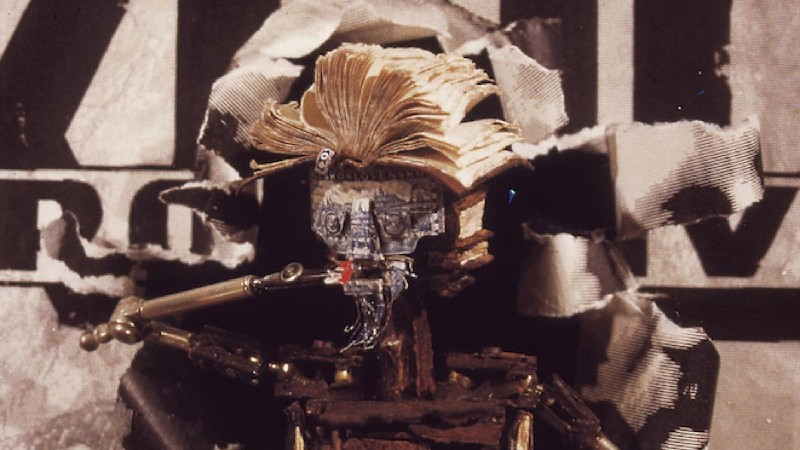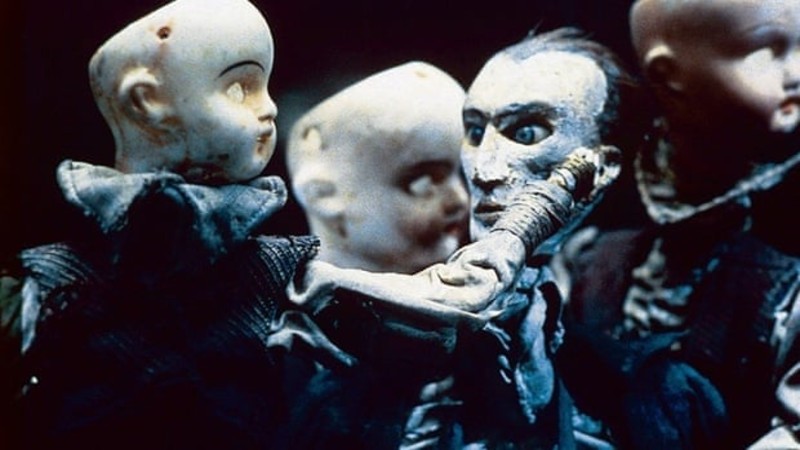




How do you sell a fragrance in movies? Moving pictures have occasionally dabbled with sense of smell over the years. At the tackier end of the market is so-called ‘scratch and sniff’ technology, famously exploited by US schlockmeister John Waters to film Polyester (1981) in ‘Odorama’. European director Tom Tykwer made a film about fragrances with his arthouse crime movie Perfume: The Story Of A Murderer (2006) in which the central character is blessed with a superb olfactory sense and spends his life searching for the ultimate scent.
And then there are the Brothers Quay whose short film Wonderwood (2010) is ostensibly a commissioned ad for Comme des Garçons’ eponymous fragrance but to all intents and purposes a bona fide Quay Brothers short that sits happily with their wider body of work.
Although they’ve made two live action feature films – Institute Benjaminta, or This Dream People Call Human Life (1995) and The Piano Tuner of EarthQuakes (2005) – the Quay Brothers are best known for their numerous short films. Essentially made using stop-motion animation, these are a far cry from the character-driven films that generally characterise that medium (think: Nick Park’s Wallace And Gromit films or, going further back, the animated beasts and mythical creatures that populate the live action special effects films of Ray Harryhausen such as Jason And The Argonauts, 1963).
Exploring character through animation isn’t really the Quays’ thing; their interest lies in taking the viewer into strange, dark and magical environments. In The Cabinet Of Jan Švankmajer (1984; pictured below; originally commissioned as sizeable inserts for a documentary about the eponymous Czech surrealist and animator) they animate a feather quill dancing around on its nib point like a skater on ice and a four section, folding wooden ruler rotating a map of Praha (Prague) as if the ruler were a pair of arms belonging to an unseen reader of the map.
Elsewhere the same film also features a doll child laying his head on a table so that when his wig comes off to reveal an empty cranium, all its contents – a series of objects including stuffing, a comb and a simple toy motorbike – can be examined by a mechanical figure representing the inquisitive Švankmajer. The twins’ imagery isn’t macabre, exactly, but there is about it a definite dark edge.
Street Of Crocodiles (1986; pictured at the bottom) may well be their highest profile short. Back in the 1980s it played London cinemas as support to a feature film which is today forgotten in the mists of time. Spittle from the lips of a live action actor’s sets in motion a system of pulleys and mechanisms while the actor cuts a thread with an ancient pair of scissors to release a tailcoat-clad puppet into a rundown and threatening, off-coloured, urban world.
It’s a place where screws reverse out of the ground and wilfully roll away picking up the dust as they go and pocket watches open to reveal themselves as containers of raw red meat. Both a sense of physical corruption and decay and an undeniable Eastern European sensibility pervade the whole thing, as they do all their films.

.
Crossing the pond
The Quay twins grew up in Norristown, Pennsylvania, a town near Philadelphia with a large European immigrant population. Their resultant interest in European culture was boosted at Philadelphia’s College of the Arts where Stephen studied film and Timothy illustration. Here they were exposed to the world of Polish poster art in general and the work of Jan Lenica and Walerian Borowczyk in particular.
Just as these two Polish artists used that medium as a springboard to animated filmmaking (and, in the case of Borowczyk, live action), so did the US-born Quays by way of London’s prestigious Royal College Of Art. Other influences, all European, included writers Franz Kafka, Bruno Schulz and Robert Walser, composers Leszek Jankowski, Zdeněk Liška and Karlheinz Stockhausen, artists Giuseppe Archimbaldo and Honoré & Jean-Honoré Fragonard, and animators Wladislaw Starewich and the aforementioned Jan Švankmajer.
Despite the twins’ protests that their artistic sensibilities were pretty much fully formed by the time they discovered Švankmajer in the early 1980s, he is probably the artist with which more than any other they’re most readily associated.
Towards the end of the 1970s following a brief period of living in the Netherlands, the Quays joined with former fellow RCA student Keith Griffiths who has continuously acted as their producer under his Koninck Studios banner ever since, with the Brothers setting up and operating out of their studio production space in Southwark, London.
.
The world of publicity
This was the latter part of the British commercials boom that aided the early careers of film directors Adrian Lyne, Ridley Scott and others. To pay the rent and allow them to make their more personal short films, the Quays too took on commercials work, chalking up such clients as Doritos, Dulux Wood Protection, Fox Sports, Honeywell, ICI, Murphy’s Instant Stout, Nikon, Rice Krispies, Walkers Crisps and the Partnership for a Drug-Free America. Alongside Bristol’s Aardman Animations, they also contributed a section to the widely-seen pop video for Peter Gabriel’s Sledgehammer.
Ad agencies who commission commercials on behalf of clients usually take a fairly hands-on approach to film production companies, with imagery locked down at script and/or storyboard stage to make sure the client is happy with what they’re getting. Recognising the twins’ highly idiosyncratic, creative leanings, Rei Kawakubo and Adrian Joffe of Comme des Garçons opted for a very different tack. In 2010, prior to launching Wonderwood, a new fragrance for men which featured among other things sandalwood, Virginia cedar and cypress, they contacted the Quays to make a commercial for the fragrance. The brief was – well, you know about the kingdom of wood… run with it. Unsurprisingly, the twins took up this generous offer since it basically commissioned them to make a Quay Brothers short.
As part of their daily production ritual, the brothers sprayed and walked into the perfume to get a feel of what it was about. Further inspiration came from past or present pieces of wood some of which they’d kept under their beds for the best part of a quarter of a century. If there was a kingdom of wood, the issue then was, how should they approach it?
The brothers fell back on the well-worn cinematic device of the observer or onlooker who looks through a peephole to access a mysterious, secret world. Because their filmic medium is stop-frame animation, that means the character had to be a three-dimensional stop-motion puppet. All we ever see of him, however, is his eyes and nose and occasionally his mouth cropped by the edge of frame, his head sometimes moving before we’ve even got a good look at those facial features (although we do momentarily see the full face a couple of times, including right at the end of the film).

.
Smells of secret spirit
This observer figure is never more than that: there is no attempt whatsoever to develop him as a character: he’s no more than a furtive, barely glimpsed presence – and only a face at that. However, since he represents us, the viewer, this person looking at the strange world and wanting to know more about the scents associated with it, he scarcely needs to be any more than that. The real show is elsewhere, in the forest itself.
The mysterious, secret world of the forest is itself to all intents and purposes a character. The term ‘forest’ is misleading, for the viewed environment is broken up into various smaller sections by the twins’ mise-en-scène.
A sheet of cloth is pulled back as if by invisible hands to reveal a surface strewn with pinecones out of which grow strong, green plant forms. A strangely curved, four-sided frame contains patterns that move away like theatrical curtains to reveal fruits, pinecone stems topped by rounded cones like an all-wooden equivalent of a tree complete with full-blown foliage. The segmented surfaces of the cones undulate as the images are manipulated via some sort of visual trickery. Red and cream coloured, lengthy forms fall through dark space to land on an area like leafless tree stumps shorn of branches covering a patch of ground.
Those familiar with the work of Czech Surrealist animator Jan Švankmajer will recognise a borrowed editing trope. In many of his shorts, Švankmajer will show rapid fire, serial close-ups of an object such as, say, a piece of hessian to both give an impression of that object and make its presence felt within the filmic flow. In Wonderwood, the Quays treat the flat elements functioning like a screen within the curved, four-sided frame in much the same way.
.
Unorthodox format
It’s tempting to use the word ‘narrative’ rather than flow, but like those of the Quays Švankmajer’s films themselves sometimes deal in non-narrative episodes and/or ideas. That said, the Quays’ films often have about them the element of the wilfully obscure, an element in which they seem to take a perverse delight, far more so than the rather more narratively-inclined Švankmajer.
Around the upright pine cone constructed ‘trees’ and other vegetation hover birds somewhere between a hummingbird with its hovering motion and a woodpecker with its beak periodically hammering repeatedly into wood to make segments fall to the ground below, the hammering reinforced on the soundtrack by rat-tat-tat-tat-tat rhythms in composer Timothy Nelson’s delicate yet lush, accompanying soundtrack music.
Finally, the various wood fruits and forms turn into flat shapes which move around to form a parquet floor- already glimpsed as a pulsating pattern – with the different coloured wood types going to make the geometrical pattern thereupon, over which rolls a green comb as if on some strange journey of discovery. The orange-y red and yellow curtain falls and the puppet head, which has been watching all this throughout, basks as if in the glow of what it has just been watching.
You might not get all this out of a single viewing of Wonderwood, but then the Quay’s works aren’t conceived so much as single viewing pieces as films to be watched again and again over a long period. To do that, your best bet is to get hold of the superb UK Blu-ray that the BFI released in 2016 entitled Inner Sanctums – Quay Brothers: The Collected Animated Films 1979 – 2013 which contains all the shorts, Wonderwood included. (An earlier BFI release on DVD, whilst also excellent, only goes up to 2003.)
The UK Blu-ray also contains numerous other essential filmic and written bits and pieces including the short documentary Quay (2015) by Christopher Nolan (feted director of Memento, 2000, The Dark Knight, 2008, Inception, 2010 and Dunkirk, 2017) which provides an excellent introduction to the Quays’ work.
Wonderwood is a commercial for the perfume of that name by Comme des Garçons:
.
This is the second is a series of articles in a partnership with the magazine Doesn’t Exist. Just click here for more information, and to order your print edition right now!






